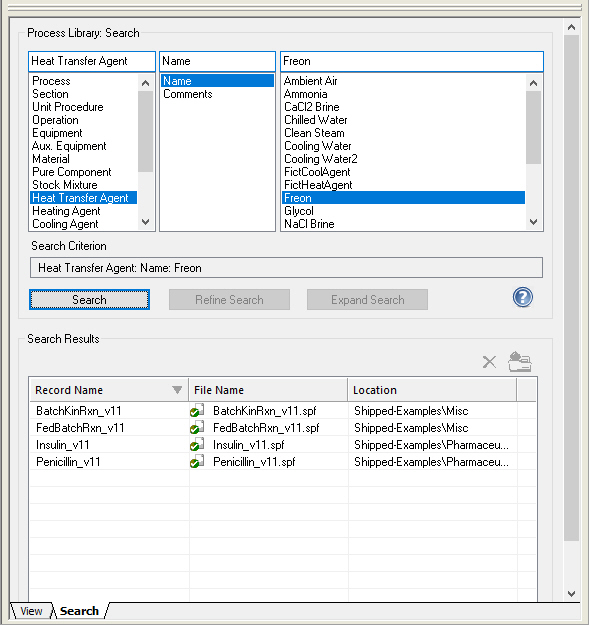

From this interface you can search your database of process models deposited in your library in order to find one (or more) that meet your criteria. As you will see, even though every time you search, you only search against one criterion at a time, it is possible to find process models that fit a set of criteria “AND”-ed or “OR”-ed together. The key lies in the pool of records that each criterion is applied.
To reiterate: The steps needed to perform a search are:
a) Compose a search criterion.
b) Search over a pool of candidate records that can be either the entire set included in the database or the set found in a previous search.
A search criterion is essentially a statement about a property of some entity in a process model, and a comparison mode used to either include or exclude models in the matching set. Typical criteria are statements like:
● A process (flowsheet) that includes loops.
● A heat transfer agent with the name “CX2060”.
● A pure component with company name “RU-3443”
● A process with batch size greater than 100 kg / batch
The compose a search criterion you must choose three parts:
1. The entity that is targeted; it could be a Pure Component, or a Heat Transfer Agent, or an Equipment; you select that in the first list box.
2. The property of the Entity that the statement is about; it could be “The Company Name” of a Pure Component; or the “The Type” of Equipment; or the Batch Size of a Process (Flowsheet). Clearly, the property type depends on the chosen entity that the criterion statement is about. That’s way, first you pick the entity in the first list; then from the second listbox, you select the name of the property.
3. The value of the property and the matching mode. Again, the options depend on the property type. If the property is a “True/False” statement (like ‘has recycle loops’), a binary choice is shown; if the property has a string value (e.g. the type of equipment), then a listbox with the available choices is presented; if the property can have a numeric value (e.g. the batch size of a process), then a numeric field is shown, preceded by an operation for larger, larger or equal, equal, smaller and smaller or equal.
If and when a criterion is properly formulated (as shown in the text box), the button labeled “Search” becomes active. The other two buttons (“Refine Search” and “Expand Search” may or may not become active; more on that later). Now you are ready to execute your search against the composed criterion:
When you click on “Search”, the search engine will scan through all the records in the process database and present a listing of all records that match the composed criterion. The listing of all matches will be called ‘matching set of records’ and it is shown in the table below.
Once you have a matching set of records, you can now compose another criterion and then click on “Refine Search”. This time, the searching engine will search for a new ‘matching set of records’ to your new criterion, but the search pool or records will be the previously established set of matches (not the entire pool as contained in the database). Therefore, any results that are now presented, are essentially those that match both criteria (the first AND the second). In essence, this is the result of matching two criteria AND-ed together.
Once you have a matching set of records, if you compose another criterion and this time click on “Expand Search”, the searching engine will search in all the records in the database and whatever records it finds that match your new criterion will be added to the previous set of matching records, in essence, executing an “OR” between the two criteria. Therefore, the new listing shown in the table, will be the result of searching in the entire pool or records the two criteria “OR”-ed together.
When you select a line in the table of resulting matches, you can click on  to open the .spf file behind the record for editing / viewing in SuperPro Designer.
to open the .spf file behind the record for editing / viewing in SuperPro Designer.
If you click on the  button (with a record selected), the selected record will be deleted from the process database.
button (with a record selected), the selected record will be deleted from the process database.
|
|
After clicking on the Delete from Database button the selected record(s) will be deleted from the database itself and that action is not reversible. The related .spf files will still remain in your PLRF, so if you later change your mind, you can redeposit them in the process database. |
If you click on the  button a help screen with useful information about how to use the ‘Search Tab’ will appear (this content).
button a help screen with useful information about how to use the ‘Search Tab’ will appear (this content).